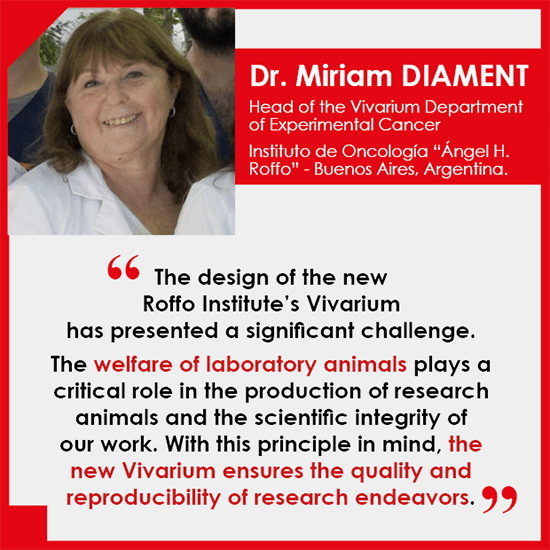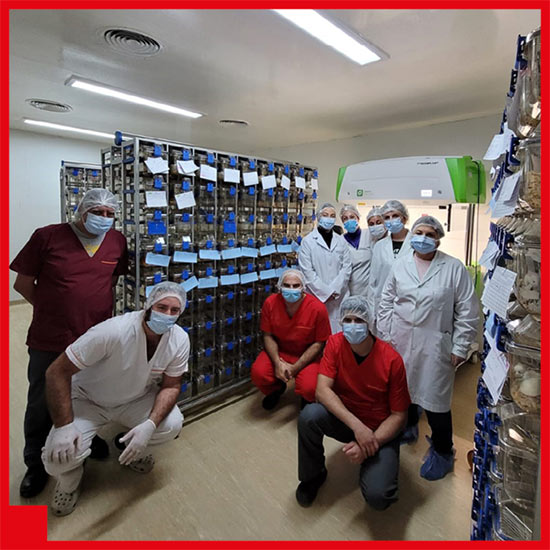
The current version of the Tecniplast website doesn't match your region. Please visit your local website to find information and offerings specific to your country.

The current version of the Tecniplast website doesn't match your region. Please visit your local website to find information and offerings specific to your country.


Panorama meets Dr. Miriam Diament, Head of the Vivarium Department of Experimental Cancer (Jefe del bioterio Departamento de Cancer Experimental) at the Instituto de Oncología “Ángel H. Roffo” in Buenos Aires, Argentina.
The Roffo Institute is a renowned cancer research and treatment center. Established in the early 20th century, its primary mission is to conduct cutting-edge research into the causes, prevention, diagnosis, and treatment of cancer.
Over its century-long history, the Roffo Institute has played a significant role in cancer research, education, and patient care in Latin America, and it stands today as a leading center for advancing scientific knowledge and improving outcomes for cancer patients.
The Roffo Institute features a large Vivarium for rodents. Tecniplast is proud to have contributed, along with their local distributor Lobov, to the redesign of the area, now equipped with state-of-the-art solutions that assure the quality and reproducibility of scientific outcomes while prioritizing animal welfare.
In this interview, we accompany Dr. Miriam Diament as she discusses the project, the challenges encountered, and the achieved outcomes.
The design of the new Roffo Institute's Vivarium has presented a significant challenge. Given the necessity of preserving the existing building, it was imperative to plan the facility from the outset to align with the research requirements of our institution, both for fundamental research and to accommodate potential shifts in research directions.
The welfare of laboratory animals plays a critical role in the production of research animals and the scientific integrity of our work. Any alterations made to the laboratory animal environment must prioritize enhancing their physiological well-being and providing stimuli tailored to their species-specific needs. With this principle in mind, the new Vivarium ensures the quality and reproducibility of research endeavors. We have the capability to maintain digitized records of environmental conditions in all animal rooms and receive real-time alerts for any deviations. We've also implemented a double-door autoclave in the washing area, as well as a dedicated clean storage area.
In addition to individually ventilated cages, we have introduced ventilated cabinets, changing stations, mini racks for the secure housing and transportation of animals, and a recovery rack for post-surgical care, significantly improving the immediate post-surgical recovery period. The biosafety cabinet is a crucial piece of equipment for working with immunocompromised animals, particularly for manipulation and surgery. In the washing area, we've included a waste disposal machine with rapid extraction to ensure operator safety.
All these features facilitate the execution of research tasks, enhance working conditions for our staff, and provide the space needed for collaborative projects with other research teams.
The acquisition of new equipment, along with a facility that complies with international standards for a vivarium, will enable the breeding and maintenance of new transgenic and immunosuppressed lines required for oncology and tumor immunology studies. This broadens the possibilities for new projects involving appropriate animal models, a prospect that has been constrained in our country due to the limited availability, and in some cases, the complete absence of animals with these characteristics. It's worth noting that we have a highly specialized team in place, including a veterinarian with expertise in animal welfare, two vivarium technicians, a sterilization technician, and three vivarium assistants. This, in conjunction with the new equipment and infrastructure, equips us to deliver high-level services for animal experimentation.

Reaching the stage of executing a project that adheres to the Vivarium's requirements posed a substantial challenge. We carefully examined all potential options and communicated them to the individuals responsible for overseeing the project. It was during this phase that we encountered significant obstacles, as the construction team didn't consistently grasp the highly specific prerequisites, conditions, and structural characteristics that a Vivarium must adhere to in order to fulfill its purpose.
As a result, all Vivarium staff members continually contributed their observations on a daily basis to convey the requirements and implement the necessary adjustments throughout the project, ultimately leading to a successful completion.
When faced with the challenge of designing a new vivarium, it is crucial to thoroughly explore various options, visit existing vivariums, and gather insights from personnel who have daily interactions with animals. It's essential to have a clear understanding of the vivarium's purpose, whether it's primarily for housing, production, and/or research, the specific species it will accommodate, their microbiological status, the available construction space, and the intended end-users, in order to allocate appropriate areas.
Furthermore, the design should incorporate adaptability to accommodate new research directions and evolving requirements. Giving due consideration to the washing area and materials handling section is of utmost importance, ensuring that all staff can work comfortably while prioritizing safety and efficient material management.
The introduction of individually ventilated cages represents a significant advancement for our Vivarium, as it offers an ideal micro-environment for the animals. Accommodating different strains and sexes within a limited physical space has proven highly advantageous. Since their implementation, we have observed that the animals maintain optimal temperature and humidity conditions, and when the bedding is changed, it remains dry and free from ammonia odors.
The cage dimensions have allowed us to continue utilizing the same enrichments as we did with conventional cages, prioritizing the animals' well-being by providing them with familiar tunnel sizes and materials. The quality of the materials simplifies the cleaning and sterilization processes. Additionally, the built-in filters in the equipment, combined with the ventilated building system, enable the optimization of environmental conditions, enhancing the well-being of both the animals and the staff working in the facility.
This collective effort ensures the animals' well-being is of the highest standard.